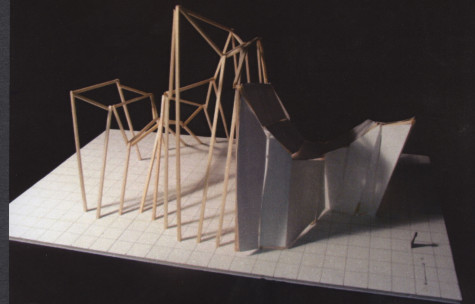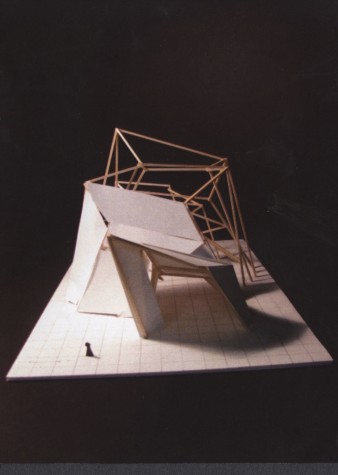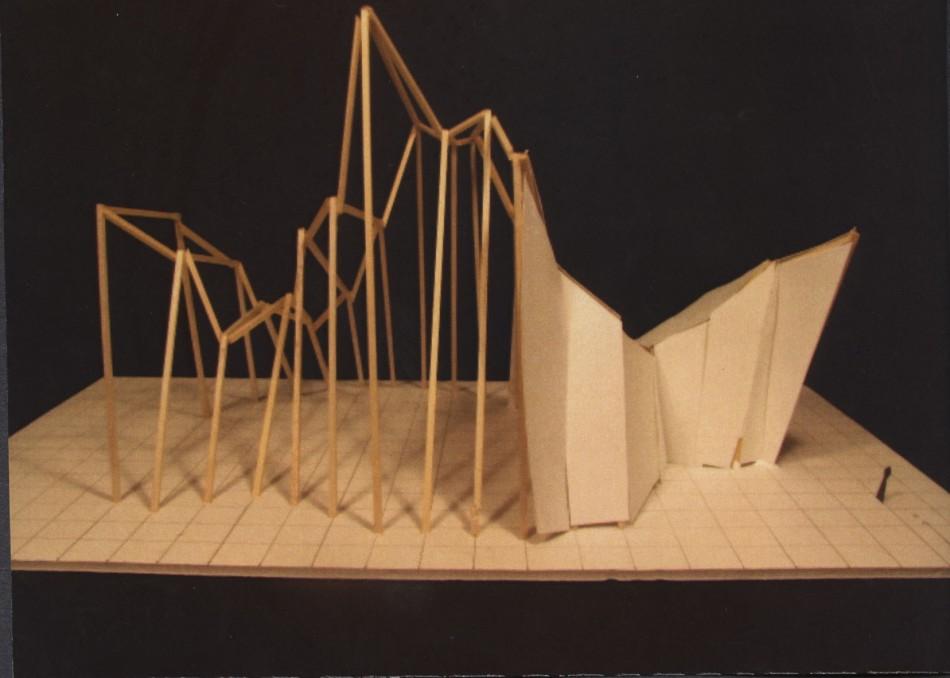Fashioning her own path
April 7, 2014
Photo Credit: Briana Garcia
One of many steps toward the final project, Garcia’s work displays many of the techniques she studied during her time at Parsons.
GLEN ROCK, N.J. – The walk was refreshing. Passing the same tree made the city seem more ‘earthy.’ There was the Starbucks she would walk into every day before her classes. It was a small café, and it was always super packed no matter what time of day.
She said it was confusing, why would so many people go into this small Starbucks when there was a much larger one just a block the other way?
After her Starbucks run, all she had to do was walk a block and there it was. She would be standing outside Parsons: The New School for Design.
Briana Garcia, a junior at Glen Rock High School, said it was a school “that teaches you everything you would ever need to know, and more, about the subject you’re learning.”
The school was like an encyclopedia to Garcia, everything she wanted to know she had complete access to. It made the most complicated subject seem like the easiest to master.
But it was also mysterious; there were such tedious steps to get an answer. Never would she get a straight-up answer, but rather she had to look for it and connect it to the previous things she had learned.
The school had many secret ‘doorways’ – no, not physically. But everything Briana learned how to do then led to another project and another step. Nothing was ever really 100% completed.
Most artists describe their work as never being finished; they always feel like they can improve on their work.
Walking up to the building on a hot summer morning with a cold Starbucks drink in her hand, seeing Parsons on the building’s facade, Briana was overcome with a warm feeling, like the feeling of coming home.
This was the beginning of her summer program and her passion for architecture.
She described the hallways as warm and full of colors, nothing like the outside of the building. There wasn’t a spot of white seen on the walls unless it was put there purposely. From the outside, it just looks like any other school but, as soon as the doors open, it’s a whole new world.
But the world she had just walked into wasn’t scary. She had no clue where she should go the first day. She asked three people where the class was and still couldn’t figure her way to the class. Even though she was lost in this huge college, she wasn’t frightened. She thought of it as a scavenger hunt, and the prize was getting the best education on architecture.
For Briana, walking in the classroom the first time was almost culture shock. There were so many people with different accents, languages, and styles. It’s like she had walked into a world fashion magazine.
Some of the students who had come from the same countries had on similar styles of clothes. Compared to the other students, though, they looked totally different. It was almost a slice of the “in” clothing of other countries.
Reluctant to meet others, the students intermingled with people they shared similar characteristics with. The French students sat with other French students, and the Italian students sat with the other Italians. It was like that for every single ethnic group.
Nonetheless, these students all had very different personalities, regardless of where they were from. If one kid was missing from the class it wouldn’t have been the same, recalled Garcia. Each and every one of these kids was different.
But they all had the same goal.
Each of these students, no matter how far they traveled, was there for the same reason. Their goal was to leave Parsons, a school of art and design, with the knowledge to be an architect or designer.
Briana Garcia, who commuted from Glen Rock, NJ, quickly realized that the two train rides and two block walk weren’t that bad to travel. Other students had taken a fourteen hour plane ride just to get to New York City.
After a day of learning about each other and the professor, they started their first project.
The first lesson: the catenary technique
Garcia was excited to start; she wanted to get to the “good stuff.” She wanted to take in all of the information that she could.
But before getting to draw or design anything, the class had to learn about the ‘catenary technique.’ The catenary technique is an object having the general shape of a curve. In architectural terms, it’s a design tool created by Antonio Gaudi who wanted to create complex structures based on curves that are perfectly flexible with dense strings suspended from their endpoints.
In the architecture summer program, the instructors had students create an entire project around Gaudi’s technique.
The professor got in front of the class that day and presented a power point. The presentation included different techniques used by architects to create all types of structures. The technique she focused on was the catenary technique, which was first used by Robert Hooke to rebuild St. Paul’s Cathedral. The word catenary is derived from the Latin word catena, which translates to “chain.”

The Latin translation, significantly, relates to the way chains are used in the technique to create three-dimensional models of structures. After viewing a few complex catenary models, including Antoni Gaudi’s famous model at Casa Miliá, it was then when the professor told the class that their assignment would include constructing their own catenary models.
Garcia was quite excited to begin work when her professor interrupted yet again, informing the class that they would not be starting just yet. The project would also require an understanding of structure and space through model drawings.
Open to the idea that she was going to be learning before she could pick up a pencil, she was eager to hear what her professor had to say.
The class found out that they would be sketching a human model who was hired to come in later that day. Garcia had seen people sketching models in movies but never thought that she would be doing it herself.
Once she heard a model was coming in she wondered if she was in the right class. Models had nothing to do with architecture – at least that’s what she thought.
Before the model came in Garcia was assigned a partner. Her name was Tara. She was one of the few students who also lived in New Jersey.
Tara was not the most outgoing girl in the world, as Briana described her. She was quite shy and hard to approach at first, but she came around.
The girls had lunch together every day, and they had this one spot in a park where they usually sat unless they got sushi at Whole Foods.
She had short hair to her shoulders, lifeless, probably from straightening it so much. She was very thin to the point that her neck resembled a giraffe’s. When they first met, she was wearing a pink crop top with jean overalls over it.
Tara was quiet and very shy, Garcia’s exact opposite. Nevertheless, Briana Garcia made it her personal goal to get Tara to express herself and become more outgoing.
They sketched for about an hour with different exercises, including blind drawing and timed drawing. The purpose of the exercises was to understand the structure of the human body. The human body itself was described as a building block for this project. The sketches were not meant to be detailed but to show the different shapes that were observed throughout the model’s body.
That’s when it clicked for her. She was including shapes in her drawings. And shapes had everything to do with architecture.
After gathering the sketches, they chose their favorites and put them together into a portfolio. Garcia and her partner were both unsure how their sketches would connect to the catenary technique, but they would have to wait until the following day to find out.
Garcia came into the classroom the next day expecting to learn and draw some more. However, that’s not what her professor had planned for that day.
Briana was told that the next task was to cut out the sketches they did the day before into shapes that would outline the poses of the model and place them together to form a more interesting and larger shape. Garcia took her time cutting out these shapes; she wanted to make sure she was doing it correctly. She was determined to impress her professor.
After presenting the shapes, they outlined each shape onto a foam board. Garcia recognized that her best sketches and shapes would combine with her partner’s to form something better than what they had produced individually.
This showed her the importance of collaboration and how architects typically work in group-environments. That’s something she had never thought about. She was excited by the idea that two people with great ideas could come together to make something magnificent.
The shape Garcia and her partner made would become the basis for the rest of the project. She was excited to start the project but still wondered what it had to do with the skill they learned the day before, the catenary technique.
She was only further confused when her professor told the class to cut the shapes out of the foam board.
But the next step immediately brought back the idea of the catenary technique.
They attached two additional foam boards to the piece containing their shape, positioned to hold it up in a table-like manner. They were creating a structure, like the technique says to do.
They also attached a piece behind the two shapes and then one that would act as a base. To visualize this, one can picture a box missing one side. The missing side would act as a window to what we would construct inside the box.
Once the box was complete, their professor told them to bring in string the next day. Briana asked what the string would do for the project and learned that the string would act as a substitute for a chain in order to practice the catenary technique.
Through the opening of their shape on the top of the box, they would hang string to form arches. In order to do this, they had cut pieces of string of different lengths and attach each end to the edge of the shape.
The purpose in having strings of different lengths was to create arches of various sizes. The arches were not to be angled, which meant that each end of a piece of string had to reach the same point of its other end on the opposite side of the shape.
From a top-down view of the box, it looked as if a straight line could be drawn along the ends of each piece of string. The process of hanging the strings was quite tedious. Garcia, a self-proclaimed perfectionist, wanted to make sure that the string was exactly what her professor envisioned. They had many pieces, and the girls created an interesting shape.
New techniques, old techniques
As the class progressed, Garcia discovered that this technique was used quite often in architecture. The edges of the arches formed by the strings were meant to come together to represent the roof a structure. What is interesting about this type of representation is that it shows an upside-down view of its structure rather than the typical view.
The professor definitely had fooled them into thinking the first project was complete, but in reality it was just starting.
As if their catenary models were not fascinating enough, they were told that they would be constructing an additional model of their structure. The process was continuing.
This next model would involve using an architectural scale to measure how much space their structure would take up in a real construction site. This is clearly important to architecture. The class was nervous when they were also told that this model would involve more tedious work than the last one. Everyone’s facial expressions changed from feeling confident and accomplished to shocked and nervous.
The next step was to trace a grid onto a piece of foam board, then they would adjust the catenary models previously created.
So, as they were instructed, they attached additional pieces of string to their arches to connect the pieces of string to the bottom of the nearest sides of the box. To put it in another way, the arches would now be pulled to form arches that now contained multiple sides. To make the structure stronger as a whole. The shapes of the arches were now changed from the classic parabola shape to a more “free-form” shape.
The next model would be the final representation of the structures. They were assigned to construct this model with thin wooden sticks that would be glued to represent the arches created in the catenary models.

The measurements they took of the segments in their arches would be converted to fit the scale of the new model. Constructing the new model was extremely tedious, and Garcia even stayed after class a few times to work on it.
What she found funny was that the hardest part was making sure the sticks glued together tightly. The glue they had to use was awful, which meant that it took over ten minutes to glue two sticks together.
Another challenge was eyeballing the angles at which each stick had to be cut in order to form the exact arch needed. Building the final model took a few days but was definitely worth the tedious work.
The last part of the project was to presenting the models to a few professors and architects. They were expected to speak in front of the entire class about the entire design process and what inspired them to create every minute detail of the structure.
Briana and her partner thought that their structure would make a wonderful theater for plays and other shows.
She was shocked to find that the professors loved the design and were engaged in her explanations. This gave her hope for the future since her career path requires public speaking. Briana says that her plan would’ve been useless without a proper explanation.
Luck of the draw
Briana Garcia learned much from working on this project with Tara. Her professor said that they worked the best together out of everyone in the class, and she knew it was true. Garcia was the more creative one, and Tara knew how to work quickly and efficiently while also incorporating her ideas.
Tara was so determined to get things done and really knew how to focus. Garcia admired that trait: usually took her forever, but she learned about problem solving and making good decisions in a short amount of time. Tara was all for that; she knew how to fix every little issue they had.
The class, overall, taught Briana a lot about the approach to projects. She learned about the types of projects she could be doing in college. Presenting her project to the entire class and professors also made her realize the importance of being able to communicate her ideas.
Briana knew that she had good ideas, but she thought a lot about how she would want to tell the professors.
Briana had just enough courage to go up there and speak. It was enough.
They ended up loving it because of the detail she went into. It showed her that communication sometimes is the only thing holding people back. She decided she doesn’t want anything to hold her back from creating.
Unfortunately, during this whole process Briana and Tara had not formed much of a friendship. Even though Tara had opened up a little, they were more of just partners in a project.
At first Briana was disappointed in the fact that they didn’t become great friends. Then she had a realization that in life one can’t always like the people she is instructed to work with.
They have kept in sporadic touch, as they follow each other on Instagram.
Garcia will be returning to Parsons this summer to continue her education in architecture. She looks forward to learning new things and expects to leave Parsons this summer with a bundle of knowledge about architecture.
She has also decided from taking this summer class that she will like to take on architecture in college, and hopefully a career in the future.
The pictures featured in this article are pictures of Garcia’s project. She had not taken any pictures of her other projects because she was the most proud of this one.
Garcia’s mom, Karla, said that she’s happy that her daughter knows what she wants to do. She’s very proud of her and what she has to offer to the world.
She thinks the summer program has opened her daughter’s eyes to the world of architecture and design.
Karla has said that if Briana didn’t take the class, she would most likely not have known or discovered her passion for art as soon as she did.
